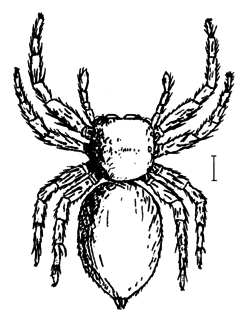
Mantius is a spider genus of the jumping spider family, Salticidae.

Prostheclina pallida is a species of spider in the family Salticidae, native to Eastern Australia. It was described by Keyserling in 1882, and remained the only species in the genus until 2007, when six more species were described.
Lophostica mauriciana is a species of spider in the family Salticidae. It is found only in the islands of Mauritius and Réunion in the western Indian Ocean.

Tarantulas comprise a group of large and often ″hairy″ spiders of the family Theraphosidae. Currently, about 1,000 species have been identified. The term tarantula is usually used to describe members of the family Theraphosidae, although many other members of the same infraorder (Mygalomorphae) are commonly referred to as "tarantulas" or "false tarantulas". Some of the more common species have become popular in the exotic pet trade. Many New World species kept as pets have urticating hairs that can cause irritation to the skin, and in extreme cases, cause damage to the eyes.

Macroglossum gyrans is a moth of the family Sphingidae. It was described by Francis Walker in 1856 and is known from South-east Asia and Madagascar.
This glossary describes the terms used in formal descriptions of spiders; where applicable these terms are used in describing other arachnids.

Cyrtophora parangexanthematica is a species of tent spider found in the Philippines. Its scientific name comes from its close resemblance to double-tailed tent spiders. It was described from a single female specimen collected in 1995.

Micrommata ligurina is a species of huntsman spider. It was first described by Carl Ludwig Koch in 1845.

Trite auricoma, commonly known as the golden-brown jumping spider, is a species of jumping spider endemic to New Zealand.
Lycinus frayjorge is a mygalomorph spider of Chile, named after its type locality: Parque Nacional Fray Jorge, Limarí, Region IV (Coquimbo). The female spermathecae are most similar to those of L. gajardoi, which differs by the less numerous maxillary cuspules, the lighter scopula IV, and the presence of pseudopreening combs.

Tigrosa helluo is a species of spider belonging to the family Lycosidae, also known as wolf spiders. T. helluo was formerly known as Hogna helluo before differences between dorsal color patterns, habitat preferences, body structures, etc. were discovered. The species is native to the United States, Canada and Mexico. They can be found across the eastern half of the United States, primarily in the northeast and New England, and as far west as Nebraska and Kansas. T. helluo can be found in diverse habitats including woods, marshes, fields, and riparian areas. Typically, members of this species prefer to live in wetter areas as opposed to dry environments. Males tend to live for around a year and females will live for close to two years.
Zorodictyna inhonesta is a species of spider in the family Udubidae, found in Madagascar. It was first described by Eugène Simon in 1906 as Uduba inhonesta. Pekka T. Lehtinen transferred it to the genus Zorodictyna in 1967, although Pierre L.G. Benoit was still using the name Uduba inhonesta in 1972.
Orphnaecus dichromatus is a species of selenocosmiine tarantula, in the Phlogiellini tribe.

Hexathele is a genus of funnel-web spiders endemic to New Zealand that was first described by Anton Ausserer in 1871, though most others have been described by Raymond Robert Forster. Originally placed with the curtain web spiders, it was moved to the Hexathelidae in 1980.
Prosisyrina is an extinct genus of lacewing in the neuropteran family Sisyridae. The genus contains two described species, Prosisyrina sphinga and Prosisyrina sukachevae. Prosisyrina is known from a group of Late Cretaceous fossils which were found in Asia.
Augacephalus breyeri is a species of harpactirine theraphosid spider, found in South Africa, Mozambique and Swaziland.
Blanioonops is a genus of spiders in the family Oonopidae. It was first described in 1922 by Simon & Fage. As of 2016, it contains only one species, Blanioonops patellaris, found in East Africa.
Exechocentrus is a genus of Madagascan orb-weaver spiders first described by Eugène Simon in 1889. It is a bolas-using spider, capturing its prey with one or more sticky drops at the end of a single line of silk rather than in a web.

Neoscona byzanthina is an orb-weaver spider.
Exechocentrus lancearius is a species of spider in the orb-weaver spider family Araneidae, found only in Madagascar. It was initially described from a partial specimen of an adult female. The first description of a complete specimen and its prey-catching behaviour was published in 2012. E. lancearius is a bolas spider. Rather than using a web, adult females catch their prey by using a line with one or two sticky drops which they swing.









